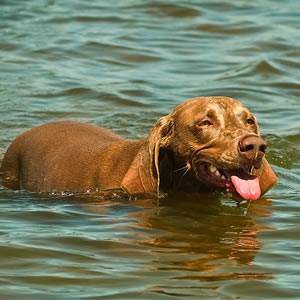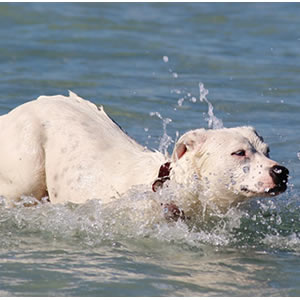
July 10th, 2020 by
Swimming is a great form of exercise for our four-legged friends. Swimming is gentle on joints and tires our dogs out faster than walking, plus it’s fun! There are some important points to consider, however, before you let your dog take the plunge and jump into a body of water!
 Does your dog like water?
Does your dog like water?
Some dogs may be happy to paddle in puddles or shallow waters but can be reluctant to go further than where their feet touch the floor. It is a myth that all dogs are born with the innate ability to swim, so throwing your dog in at the deep end, so to speak, is probably not a great idea! For your dog to enjoy swimming it’s important to build up their confidence with water and let them splash around in the shallow, to begin with, is a good idea. Taking your dog to a local hydrotherapy pool is also a good way to build up their confidence, as this will be done in a controlled and safe environment.
Your dog’s breed
Not all dogs take to water the same. Some breeds, such as Pugs and French Bulldogs are simply not natural-born swimmers. This is because of the way their skull is, they are brachycephalic, meaning they have a short yet broad skull, which can actually cause them to sink! This is because they will instinctively raise their head when in water, causing their rear end to go down, and once they are almost vertical their whole body will start to sink. Another breed which can struggle with swimming is the miniature Dachshund, purely because of their short legs and low body, meaning they will never be strong swimmers – swimming is all in the legs!
Finding safe waters
Once your dog has a little water confidence, you need to think about the types of water you let them play around in. I’m always very conscious about making sure my dog isn’t drinking from water that could be contaminated by blue-green algae, after hearing about two dogs I knew had died from this. There are a number of other dangers that can affect your dog whilst they swim – but first, let’s look at the places where it should be safe for you to let your pooch have a swim!
Shallow rivers that are slow-moving are often safe to let your dog swim. This is because there shouldn’t be any fast undercurrents, and any debris in the water should be able to be seen. The same goes for streams, and also natural lakes. You should always ensure your dog only goes as far as they are comfortable with, and also if you let your dog swim in a river, make sure their recall is solid, as the last thing you want is your dog swimming to the other side and running up the opposite bank where you can’t get to them! A favourite walk of ours is a local wood that has a stream running through, wherein parts it is deep enough for the dogs to swim, but also shallow enough there isn’t much danger posed for them.
 Dangers from swimming
Dangers from swimming
Where not to let your dog swim
Fast flowing waters can be a danger for even the strongest swimmers. Rivers with a strong current often have a strong pull that can drag your dog away very quickly, and this then poses a danger to us as our first instinct is to try and save our pooch. Canals are often full of debris; we often see shopping trolleys that have been dumped along with various other rubbish that our dogs can catch their legs on which could cause them a nasty injury.
Blue-Green Algae
Blue-green algae which I have previously mentioned is a collection of bacteria called cyanobacteria. It is most common in stagnant water, such as lakes and ponds, and especially during hot weather – however, it can occur at other times of the year. When blue-green algae bloom, it produces harmful toxins that stop dogs’ livers from functioning properly. Exposure to it is often fatal, and some types of bacteria can even kill a dog within an hour of them drinking contaminated water. It’s especially important that if you fear there could be any of these algae present in a body of water that you don’t allow your dog to enter it. Even if your dog doesn’t drink from the water, it can get stuck to their fur and they may ingest it later on when they are cleaning themselves. Signs of blue-green algae may be a blue sheen to the water or clumps of blue-green scum on the surface of the water and maybe concentrated at the edges of the water, looking foamlike.
Too cold
Other dangers of letting your dog swim can include the water being too cold, so you should try and keep your dog out of water when it’s very cold outside, as your dog may go into shock or suffer from hyperthermia. If your dog does swim and feels very cold afterwards, it’s important to get them warmed up and dry as soon as possible. We have drying coats for our dogs that are absolutely brilliant to put on them, they are dry and warm within a couple of hours!
 Water Intoxication
Water Intoxication
Water intoxication is another problem you may encounter if your dog consumes too much water in a short period of time - causing electrolyte levels to drop, thinning blood plasma and leading to swelling of the brain and other organs. If your dog seems to be consuming too much water, and not urinating or throwing up water, this could lead to water intoxication. A dog that continually jumps into a lake with their mouth open to retrieve a ball could even be at risk of this so it's important to allow your dog to take breaks and don’t continually throw something in the water for them to retrieve.
As always if you sense your dog could have consumed too much water, or potentially swam in water contaminated with blue-green algae, you must immediately contact your vet. If your dog is vomiting after being in the water, or seems to be dizzy or lethargic these could be signs that something in the water has made your dog unwell.
Have fun!
So, making sure you take into account any potential dangers, building your dog's confidence in the water and eventually letting them swim on their own is great fun, both for you to watch (or join in if you feel like it!) and your dog to splash around! When the weather warms up again it is also a great way for your dog to keep cool – so enjoy the precious time with your pooch!
Comments
Leave a reply
Your e-mail address will not be published. All fields are required


